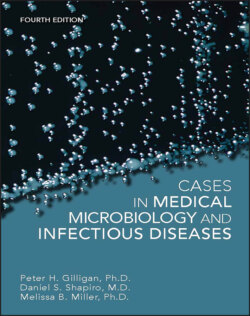Читать книгу Cases in Medical Microbiology and Infectious Diseases - Melissa B. Miller - Страница 44
CASE 3
ОглавлениеThis 16-year-old female presented to the emergency room of an urban medical center with complaints of crampy abdominal pain for days and vaginal bleeding. She denied symptoms of urinary tract infection or abnormal vaginal discharge and had not noted any chills or fever. She had no nausea or vomiting. The pain increased in the 24 hours prior to presentation, and at the time of examination she also noted pain in the right upper quadrant. She was sexually active with one male partner in the preceding 3 months and claimed to use condoms as a method of birth control. She is the mother of one child.
On examination, her temperature was 38.3°C, and there was exquisite tenderness in the right upper quadrant as well as the left lower quadrant. No rebound tenderness or guarding was noted. On pelvic exam, cervical motion tenderness was present, as well as right and left adnexal tenderness. No masses were palpated.
1 1. Clinically, this patient was believed to have pelvic inflammatory disease (PID) and was admitted to the hospital for antibiotic treatment. What bacteria have been associated with PID?
2 2. An endocervical swab was collected from this patient, and a nucleic acid amplification test (NAAT) was performed for Chlamydia trachomatis and Neisseria gonorrhoeae. Why have NAATs become the method of choice for diagnosis of these two organisms? What are strengths and weaknesses of this method?
3 3. The NAAT was positive for the more common cause of PID of the two. What was the organism? Why does PID occur in a limited proportion of women who have genital infections with this organism? What serious consequence can PID have for the infected individual?
4 4. Briefly describe the life cycle of the organism infecting this patient. Why was this organism once classified as a virus?
5 5. In addition to PID, in which this organism may well have a significant role, in what other clinical situations might this organism be expected to be recovered?
6 6. How effective are β-lactam antibiotics in treating infections caused by this organism? What is the rationale for using a β-lactam in addition to doxycycline in this patient’s therapy? What else should be done epidemiologically in cases of PID?
7 7. What type of screening strategy has been used successfully to prevent PID? What populations have a high prevalence of chlamydial infection? What are the potential consequences of PID?
